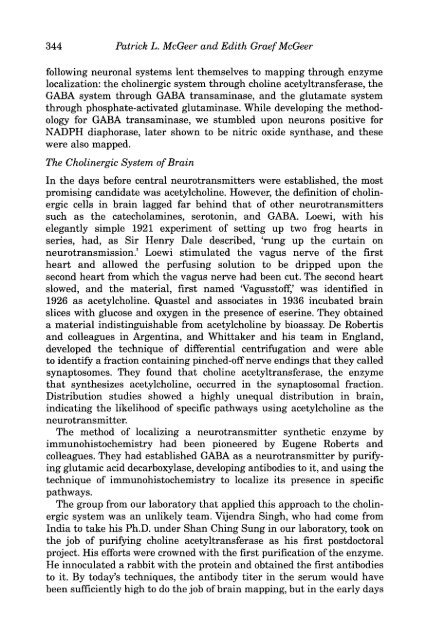Edith Graef McGeer - Society for Neuroscience
Edith Graef McGeer - Society for Neuroscience
Edith Graef McGeer - Society for Neuroscience
Create successful ePaper yourself
Turn your PDF publications into a flip-book with our unique Google optimized e-Paper software.
344 Patrick L, <strong>McGeer</strong> and <strong>Edith</strong> <strong>Graef</strong><strong>McGeer</strong><br />
following neuronal systems lent themselves to mapping through enzyme<br />
localization: the cholinergic system through choline acetyltransferase, the<br />
GABA system through GABA transaminase, and the glutamate system<br />
through phosphate-activated glutaminase. While developing the methodology<br />
<strong>for</strong> GABA transaminase, we stumbled upon neurons positive <strong>for</strong><br />
NADPH diaphorase, later shown to be nitric oxide synthase, and these<br />
were also mapped.<br />
The Cholinergic System of Brain<br />
In the days be<strong>for</strong>e central neurotransmitters were established, the most<br />
promising candidate was acetylcholine. However, the definition of cholinergic<br />
cells in brain lagged far behind that of other neurotransmitters<br />
such as the catecholamines, serotonin, and GABA. Loewi, with his<br />
elegantly simple 1921 experiment of setting up two frog hearts in<br />
series, had, as Sir Henry Dale described, Vung up the curtain on<br />
neurotransmission.' Loewi stimulated the vagus nerve of the first<br />
heart and allowed the perfusing solution to be dripped upon the<br />
second heart from which the vagus nerve had been cut. The second heart<br />
slowed, and the material, first named Vagusstoff,' was identified in<br />
1926 as acetylcholine. Quastel and associates in 1936 incubated brain<br />
slices with glucose and oxygen in the presence of eserine. They obtained<br />
a material indistinguishable from acetylcholine by bioassay. De Robertis<br />
and colleagues in Argentina, and Whittaker and his team in England,<br />
developed the technique of differential centrifugation and were able<br />
to identify a fraction containing pinched-off nerve endings that they called<br />
synaptosomes. They found that choline acetyltransferase, the enzyme<br />
that synthesizes acetylcholine, occurred in the synaptosomal fraction.<br />
Distribution studies showed a highly unequal distribution in brain,<br />
indicating the likelihood of specific pathways using acetylcholine as the<br />
neurotransmitter.<br />
The method of localizing a neurotransmitter synthetic enzyme by<br />
immunohistochemistry had been pioneered by Eugene Roberts and<br />
colleagues. They had established GABA as a neurotransmitter by purifying<br />
glutamic acid decarboxylase, developing antibodies to it, and using the<br />
technique of immunohistochemistry to localize its presence in specific<br />
pathways.<br />
The group from our laboratory that applied this approach to the cholinergic<br />
system was an unlikely team. Vijendra Singh, who had come from<br />
India to take his Ph.D. under Shan Ching Sung in our laboratory, took on<br />
the job of purifying choline acetyltransferase as his first postdoctoral<br />
project. His ef<strong>for</strong>ts were crowned with the first purification of the enzyme.<br />
He innoculated a rabbit with the protein and obtained the first antibodies<br />
to it. By today's techniques, the antibody titer in the serum would have<br />
been sufficiently high to do the job of brain mapping, but in the early days











![[Authors]. [Abstract Title]. - Society for Neuroscience](https://img.yumpu.com/8550710/1/190x245/authors-abstract-title-society-for-neuroscience.jpg?quality=85)





